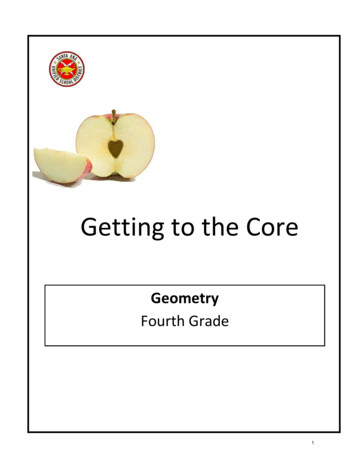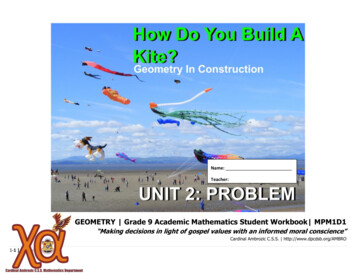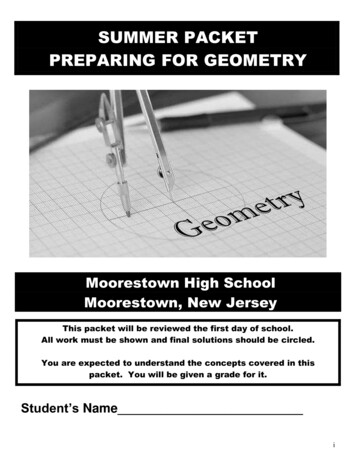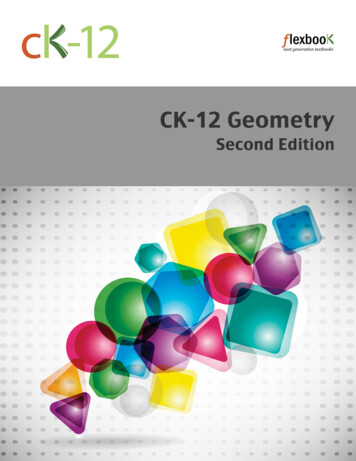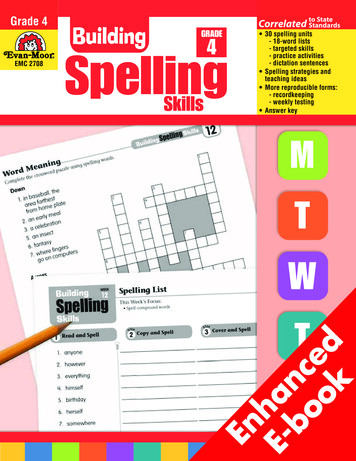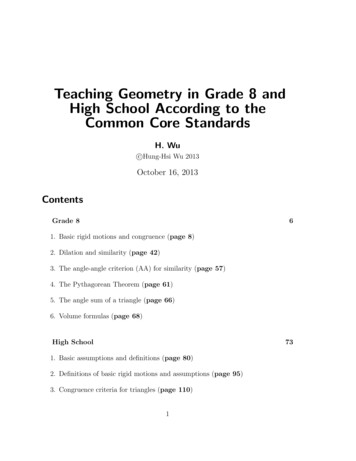
Transcription
Teaching Geometry in Grade 8 andHigh School According to theCommon Core StandardsH. Wuc Hung-Hsi Wu 2013October 16, 2013ContentsGrade 861. Basic rigid motions and congruence (page 8)2. Dilation and similarity (page 42)3. The angle-angle criterion (AA) for similarity (page 57)4. The Pythagorean Theorem (page 61)5. The angle sum of a triangle (page 66)6. Volume formulas (page 68)High School731. Basic assumptions and definitions (page 80)2. Definitions of basic rigid motions and assumptions (page 95)3. Congruence criteria for triangles (page 110)1
4. Some typical theorems (page 126)5. Constructions with ruler and compass (page 144)6. Definitions of dilations and similarity (page 149)7. Some theorems on circles (page 175)2
PrefaceThis is the companion article to Teaching Geometry According to the CommonCore Standards.The Common Core State Standards for Mathematics (CCSSM) have reorganizedthe geometry curriculum in grade 8 and high school. Because there are at presentvery few (if any) ready references for such a reorganization, this document is beingoffered as a stopgap measure.In terms of the topics covered, there is hardly any difference between what iscalled for by the CCSSM and by the other curricula. The change occurs mainly inthe internal (mathematical) reorganization and the change of (mathematical) focus.For example, transformations are usually taught as rote skills in middle school with nomathematical applications or relevance, and the concepts of congruence and similarityare talked about but never defined except in the case of polygons. By contrast, theCCSSM develop all these topics on the foundation of transformations, thereby givingthem coherence and purposefulness. The “coherence” of the CCSSM has been muchbandied about in recent discussions, but it is time to realize that the coherence ofthe CCSSM is not an educational slogan but a mathematical fact, and one of itsmanifestations is the coherence of the geometry curriculum embedded in the CCSSM.For the benefit of students’ learning, this change is a welcome development. However,it is unfortunately the case that while these basic topics are routinely discussed in themathematics literature, not much of this information can be found in the educationliterature except perhaps H. Wu, Pre-Algebra. The intentions of the CCSSM havethus become hidden for the time being. If the detailed account given in this documentis at all successful, it will furnish a bridge across this mathematical chasm for thetime being.My specific targets are middle and high school mathematics teachers as well asthe publishers of textbooks. I hope that teachers will find this account helpful in theirpreparations for the implementation of CCSSM by year 2014. If, in addition, theirschool district can offer professional development, then maybe they can make use ofthis document to articulate the kind of professional development they want. We areentering an era when teachers must take an active role in their own professional life.The CCSSM are charting a new course, and district administrators and professionaldevelopers have to work together with teachers to find their new bearings in the3
transitional period.As for the publishers, my contact with them in the past fifteen years has made meaware that their claim of not having the needed resources to improve their books is indeed entirely legitimate. Our educational system has been broken for a long time andwe have to find ways to forge a new beginning. At a time when the CCSSM are initiating a significant change in the teaching of geometry, it would be unconscionable—asin the days of the New Math—to once again ask for change without providing thenecessary support for this change. It is hoped that this document will provide sometemporary relief in the present absence of this support.This document is essentially a compendium of selected topics from the lecturenotes for the annual summer professional development institutes (MPDI) and upperdivision courses (Math 151–153) at Berkeley that I have given since 2006. I have beenadvocating this transformations-based approach to the teaching of middle school andhigh school geometry because, in terms of student learning, it is a more reasonablealternative to the existing ones (see the discussions on page 79 ff. and page 125 ff. forpart of the reason). By a happy coincidence, the CCSSM agreed with this judgment.(The reference, Wu, H., Lecture Notes for the 2009 Pre-Algebra Institute, September15, 2009. on page 92 of the CCSSM is the same as H. Wu, Pre-Algebra.) In any case,the detailed development of this approach to middle school and high school geometry,together with exercises, will be found in the following textbooks by the author: FromPre-Algebra to Algebra (for middle school teachers, to appear in late 2014), andMathematics of the Secondary School Curriculum (a two volume set for highschool teachers, to appear probably in late 2015).It may also be mentioned that I expect to post detailed student lessons for grade8 according to the CCSSM by the fall of 2014.Acknowledgements. I wish to thank Wolfgang Buettner for his interesting contributions, Mark Saul for his willingness to read through the grade 8 portion andmake suggestions, and Larry Francis for his usual excellent editorial assistance. ToAngelo Segalla and Clinton Rempel, I owe an immense debt for numerous corrections.4
ConventionsA turquoise box around a phrase or a sentence (such as H. Wu, Pre-Algebra)indicates an active link to an article online.The standards on geometry are listed at the beginning of each grade in sans seriffonts.5
GRADE 8Geometry 8.GUnderstand congruence and similarity using physical models, transparencies,or geometry software.1.a.b.c.Verify experimentally the properties of rotations, reflections, and translations:Lines are taken to lines, and line segments to line segments of the same length.Angles are taken to angles of the same measure.Parallel lines are taken to parallel lines.2. Understand that a two-dimensional figure is congruent to another if the second canbe obtained from the first by a sequence of rotations, reflections, and translations; giventwo congruent figures, describe a sequence that exhibits the congruence between them.3. Describe the effect of dilations, translations, rotations, and reflections on twodimensional figures using coordinates.4. Understand that a two-dimensional figure is similar to another if the second can beobtained from the first by a sequence of rotations, reflections, translations, and dilations;given two similar two-dimensional figures, describe a sequence that exhibits the similaritybetween them.5. Use informal arguments to establish facts about the angle sum and exterior angleof triangles, about the angles created when parallel lines are cut by a transversal, and theangle-angle criterion for similarity of triangles. For example, arrange three copies of thesame triangle so that the sum of the three angles appears to form a line, and give anargument in terms of transversals why this is so.Understand and apply the Pythagorean Theorem.6. Explain a proof of the Pythagorean Theorem and its converse.6
7. Apply the Pythagorean Theorem to determine unknown side lengths in right triangles in real-world and mathematical problems in two and three dimensions.8. Apply the Pythagorean Theorem to find the distance between two points in a coordinate system. Solve real-world and mathematical problems involving volume of cylinders,cones, and spheres.9. Know the formulas for the volumes of cones, cylinders, and spheres and use themto solve real-world and mathematical problems.uGoals of eighth grade geometry1. An intuitive introduction of the concept of congruence using rotations, translations, and reflections, and their compositions (page 8)2. An intuitive introduction of the concepts of dilation and similarity (page 42)3. An informal argument for the angle-angle criterion (AA) of similar triangles(page 57)4. Use of AA for similarity to prove the Pythagorean Theorem (page 61)5. An informal argument that the angle sum of a triangle is 180 degrees (page66)6. Introduction of some basic volume formulas (page 68)These six goals are intended to be achieved with an emphasis on the intuitivegeometric content through the ample use of hands-on activities. They will prepareeighth graders to learn about the geometry of linear equations in beginning algebra.They are also needed to furnish eighth graders with a firm foundation for the moreformal development of high school geometry.7
1. Basic rigid motions and congruenceOverview (page 8)Preliminary definitions of basic rigid motions (page 10)Motions of entire geometric figures (page 18)Assumptions on basic rigid motions (page 23)Compositions of basic rigid motions (page 25)The concept of congruence (page 38)OverviewThe main new ideas are the concepts of translations, reflections, rotations, anddilations in the plane. The first three—translations, reflections, rotations—are collectively referred to as the basic rigid motions, and they will be the subject of inquiryin this section. Dilation will be explained in the next.Before proceeding further, we note that the basic rigid motions are quite subtleconcepts whose precise definitions require a bit of preparation about more advancedtopics such as transformations of the plane, the concept of transformations that areone-to-one and “onto”, separation properties of lines in the plane, distance in theplane, and other concepts that are necessary for a more formal development. Suchprecision is neither necessary nor desirable in an introductory treatment in eighthgrade. Rather,it is the intuitive geometric content of the basic rigid motions that needsto be emphasized.In the high school course on geometry, more of this precision will be supplied in orderto carry out the detailed mathematical reasoning for the proofs of theorems. Foreighth grade, however, we should minimize the formalism and emphasize the geometric intuition instead. Fortunately, the availability of abundant teaching tools makesit easy to convey this intuitive content. In this document, we will rely exclusively onthe use of transparencies as an aid to the explanation of basic rigid motions. Thisexpository decision should be complemented by two remarks, however.8
The first is to caution against the premature use of computer software for learningabout basic rigid motions. While computer software will eventually be employed forthe purpose of geometric explorations, it is strongly recommended, on the basis ofprofessional judgment and available experience, that students begin the study of basicrigid motions with transparencies but not with computer software. Primitive objectssuch as transparencies have the advantage that students can easily achieve completecontrol over them without unforeseen software-related subtleties interfering with thelearning process. Let students first be given an extended opportunity to gain the requisite geometric intuition through direct, tactile experiences before they approach thecomputer. A second remark is that if you believe some other manipulatives are moresuitable for your own classroom needs and you are certain that these manipulativesmanage to convey the same message, then feel free to use them.In the following, a basic rigid motion will mean a translation, a reflection, or arotation in the plane, with the precise definition to follow. In general, a basic rigidmotion is a rule F so that, for each point P of the plane, F assigns a point F (P ) toP .1 Before describing this rule separately for translations, reflections, and rotations,we first introduce a piece of terminology that will minimize the possible confusionwith the language of “assigning F (P ) to P ”. We will sometimes say thata basic rigid motion F is a rule that moves each point of the plane P toa point F (P ) in the plane.This terminology expresses the intuitive content of a rigid motion better than theoriginal language of a “rule of assignment”, and is in fact the reason behind the term“rigid motion”.Now all basic rigid motions share certain desirable properties, but rather thanlisting these properties right at the beginning, we first define these basic rigid motions,namely, reflection across a given line, translation along a vector, and rotation of a fixeddegree around a point. Then we examine their effect on simple geometric figures inthe plane. Through these examples, the properties in question will appear naturally.Before proceeding further, it may be worthwhile to pursue the analogy of basicrigid motions with functions of one variable a bit further. If f is a function of the1This should remind you of the definition of a function of one variable.9
variable x, then f (x) is a real number for each real number x. So f assigns to eachpoint x on the number line the point f (x) on the number line, just as a basic rigidmotion F assigns to each point P in the plane the point F (P ) in the plane. Now,on the number line, one clearly cannot “rotate”, but the analogs of translation andreflection do make sense. The function g so that g(x) x 2 for each x “moves”each point x of the number line to a point which is the same number of units, namely,2 to the right of x regardless of what x may be. This will be seen to be the analogof a translation in the plane. Next, let the function h assign to each point x on thenumber line point its opposite x on the number line. Thus h “flips” x to the otherside of 0, and this will be seen to the analog of a reflection across a line.In general, if a rigid motion F is given, then its rule of assignment is usuallynot simple, and the effort needed to decode this description will likely distract abeginner’s attention from the geometric content of F itself. Fortunately, the ruleassociated with each of the three basic rigid motions can be given visually with thehelp of transparencies. This is what we will describe next. The additional advantageof giving the definition in terms of transparencies is that it will effortlessly revealthe above-mentioned desirable properties that these three basic rigid motions have incommon.We proceed to describe how to move a transparency over a piece of paper to illustrate the three basic rigid motions, but it is well to note that, in the classroom, aface-to-face demonstration of the the manipulation of a transparency isfar easier to understand than the clumsy verbal and graphical description given below. Please keep this fact in mind as you read.Preliminary definitions of basic rigid motionsWe begin with the reflection R across a given line L. The line L will be calledthe line of reflection of R. For definiteness, let us say L is a vertical line and let ussay two arbitrary points in the plane are given. We now describe how R moves thesepoints. Let the line L and the dots be drawn on a piece of paper in black, as in thepicture below.2 The black rectangle indicates the border of the paper.2If a teacher wants to do a demonstration for the whole class on an overhead projector, then onsome overhead projectors, it may be necessary to do the drawing on a transparency to begin with.10
Note that this pictorial representation of the plane has severe limitations: We areusing a finite rectangle to represent the plane which is infinite in all directions, anda finite segment to represent a line which is infinite in both directions. With thisunderstood, trace the line and the points exactly on a transparency (of exactly thesame size as the paper, of course) using a different color, say red. In all subsequentdiscussions of demonstrations with a transparency, the piece of papercontaining the original drawing is understood to stay fixed and only thetransparency is moved around. With this understood, now pick up the transparency and set it down again in alignment with the vertical line, interchanging leftand right, while keeping every point on the red vertical line on top of the same pointon the black vertical line. Clearly, the latter is achieved if the upper (respectively,lower) endpoint of the red vertical line is kept on top of the upper (respectively, lower)endpoint of the black vertical line. The position of the red figure of two dots and thered line on the transparency now represents how the original figure has been reflected.11
Because we want to see the new position of the reflected figure relative to theoriginal, we are going to show the red figure together with the black figure, and thiscalls for some explanation. In the classroom, the black figure will be just black, ofcourse, but for the purpose of the verbal explanation in this article, we are goingto replace the black lines by dashed black lines to suggest the correct psychologicalresponse, namely, that we are leaving the original figure behind in order to concentrateon the red figure on the transparency. Thus the dashed black figure represents wherethe red figure used to be, and is therefore just background information. (The redrectangle indicates the border of the transparency.)In other words, if we now look at the plane itself, then the rule of assignment of thereflection R is to move the points in the plane represented by the black dots to thecorresponding points in the plane represented by the red dots, but leave every pointon the vertical line unchanged. The dashed arrows below are meant to suggest theassignment:In partial symbolic notation:R(upper black dot) upper red dot,12R(lower black dot) lower red dot
The following animation by Sunil Koswatta is meant to go with this definition ofa reflection:http://www.harpercollege.edu/ skoswatt/RigidMotions/reflection.htmlIt goes without saying that R moves every point in the plane not lying on L tothe “opposite side” of L, and the two points above are meant to merely suggest whathappens in general. There is a reason why we used two points (dots) instead of onein this discussion of the reflection R. Of course, one point already suffices for thedefinition itself. However, the use of two points highlights an obvious property ofR: the distance between the original two points (black dots) is equal to the distancebetween the two reflected points (red dots). This is because the transparency is rigidand cannot be distorted, so the distance between the red dots cannot differ from thatbetween the black dots. We may formulate this fact in more precise language, asfollows. If we take two points A and B in the plane andif R moves the points A and B to R(A) and R(B), respectively, then thedistance between A and B is equal to the distance between R(A) and R(B).We refer to this property of R as the distance-preserving property. Next, we define translation along a given vector v . Let us continue with thesame picture of a vertical line with two dots on a piece of paper, and we will describehow to translate this figure. A vector is just a segment together with the designationof one of its two endpoints as a starting point; the other endpoint will be referredto simply as the endpoint of the vector and will be pictorially distinguished by anarrowhead, as shown in the blue vector below. v13
We are going to define the translation T along the given blue vector v . We copy theline and the dots and the vector on a transparency in red; in particular, the copy of v on the transparency will be referred to as the red vector. Let the line containingthe blue vector be denoted by (this is the slant dashed line in the picture below). We now slide the transparency along v , in the sense that the red vector on the transparency glides along in the direction of v until the starting point of the redvector rests on the endpoint of the blue arrow, as shown. The whole red figure is seen to move “in the direction of v by the same distance”.Then by definition, T moves the black dots to the red dots. Precisely, the rule ofassignment of T moves the point in the plane represented by the upper (respectively,lower) black dot to the point in the plane represented by the upper (respectively,lower) red dot.The following animation of essentially this translation by Sunil Koswatta wouldbe helpful to a beginner:http://www.harpercollege.edu/ skoswatt/RigidMotions/translation.htmlIf we draw the translated figure (of the above vertical line and two black dots)by itself without reference to the original, it would be visually indistinguishable fromthe original:14
So we put in the black figure as background information to show where the redfigure used to be. Then T moves the points represented by the black dots to thecorresponding points represented by the red dots, and moves each point in the blackvertical line to a point in the red vertical line. The dashed arrows are meant tosuggest the assignment.For exactly the same reason as in the case of a reflection, a translation is distancepreserving: if A and B are any two points in the plane and if T assigns the pointsT (A) and T (B) to A and B, respectively, then the distance between A and B is equalto the distance between T (A) and T (B). Intuitively, if T is the translation along v , then no matter what the point A is,the vector with starting point A and endpoint T (A) will have the same length and the same direction as v . This fact will be proved in the high school course on geometryas it follows from one of the standard characterizations of a parallelogram. In theeighth grade, it suffices to verify such phenomena experimentally by measurements.Thus if each A and T (A) are represented by a black dot and a red dot, respectively,then we have the following pictorial representation of the translation of three points.15
rrrrrrkQQ v Q(Question: If a segment joins two of the black dots, what will happen to all the pointson the segment?) We make an observation about translations: If 0 is the zero vector, i.e., the vector with 0 length, which is a point, the translation along 0 then leaves everypoint unchanged. This is the identity basic rigid motion, usually denoted by I.Thus I(P ) P for every point P .Finally, we define a rotation Ro around a given point O of a fixed degree.The point O is called the center of rotation of Ro. For definiteness, let the center Oof this rotation be the lower endpoint of the vertical line segment we have been using,and let the rotation be 30 degrees counterclockwise around this point (one could alsodo a clockwise rotation, see below). Again, we trace the vertical line segment andthe two dots on a transparency in red. Then we pin the transparency down at thelower endpoint of the segment and (keeping the paper fixed, of course) rotate thetransparency counterclockwise 30 degrees, i.e., so that the angle between the blacksegment and the red segment is 30 degrees. In the picture below, the rotated figureis superimposed on the original figure and, as usual, the red rectangle represents theborder of the transparency. By definition, the rotation moves the upper black dot tothe upper red dot, and the lower black dot to the lower red dot.30oo30OObserve that the angle formed by the ray from the center of rotation to a black dot16
and the ray from the center of rotation to the corresponding red dot is also 30 degrees.We now draw the rotated figure as a geometric figure in the plane with the dashedblack figure provided as background information to show where the red figure used tobe. The dashed arcs indicate the rule of assignment by Ro. (Note that by the natureof a rotation around a given center, the farther a point is away from the center ofrotation, the farther it gets rotated. This is why the dashed arc that is farther awayfrom the center of rotation is longer.)OSo far we have discussed rotations of positive degrees, and they are, by definition,the counter-clockwise rotations. A rotation of negative degree is defined exactly asabove, except that the transparency is now rotated clockwise.The following two animations by Sunil Koswatta show how a rotation of 35 degrees(respectively, 35 degree) rotates a geometric figure consisting of three points andan angle whose vertex is the center of the rotation:http://www.harpercollege.edu/ percollege.edu/ skoswatt/RigidMotions/rotatecw.htmlFor the usual reasons, a rotation is distance-preserving. Note that a rotation of 0degrees is also the identity basic rigid motion I.17
Motions of entire geometric figuresWe now introduce some terminology to facilitate the ensuing discussion. Given abasic rigid motion F , it assigns a point—to be denoted by F (P )—to a given point Pin the plane. We say F (P ) is the image of P under F , or that F maps P to F (P ).If you wonder about why we use the word “map” in this context, think about thedrawing of the street map of a city, for example. Are we not mapping points in thestreets one by one on a piece of paper?We have given a description of how a reflection, a translation, or a rotation moveseach point, but such information is not particularly illuminating because it does notreveal in a distinctive way what a reflection, translation, or rotation does, or howa reflection is different from a rotation. What we do next is to examine a bit howa basic rigid motion moves, not just a point, but a whole geometric figure, in thefollowing sense. Given a geometric figure S in the plane, then a given point P in S ismapped by F to another point F (P ). Now focus entirely on S and observe what thetotal collection of all the points F (P ) looks like when P is restricted to be a point ofS. For understandable reasons, we denote such a collection by the symbol F (S) andcall it the image of S by F . (We also say F maps S to F (S).) For example,in the preceding picture of the 30-degree counterclockwise rotation Ro around thelower endpoint of the vertical segment, let the lower endpoint be denoted by B andlet S denote this vertical segment.3 Then Ro(S) is the red segment AB, as shown.It makes a 30-degree angle with S.3Notice that in this instance, we are taking the picture literally and regard the segment for whatit really is: a segment. By contrast, we have, up to this point, used this segment to represent thewhole vertical line.18
APRo(P)BNow, let T be the translation along the blue vector that we encountered earlier onpage 14, and if S continues to denote the same vertical segment, then T (S) becomesthe red segment which is now parallel to S rather than making a 30-degree angle withS at its lower endpoint.T(P)PWe see that by looking at the image of a segment, we obtain at a glance a fairlycomprehensive understanding of the basic difference between a rotation and a translation, something that is not possible if we just look at the cut-and-dried descriptionsof how these basic rigid motions move the points, one point at a time.We proceed to create a geometric figure slightly more complex than a mere segment, one that will better reveal the effects of the three basic rigid motions. We adda non-vertical, solid arrow and a circle, as shown.19
Make the drawing on the paper in black, as shown, and trace the whole figure on atransparency in red, as usual. Consider first the reflection across the vertical line.Then flipping the transparency across the vertical line exactly as before, we obtainthe following reflected image of the figure all by itself.We now superimpose it on the original black figure in order to get a sense ofhow the figure has been moved by the reflection. The black figure, drawn with dots,represents where the red figure used to be.Observe that, under the reflection, the images of the two black dots are the two20
red dots, respectively. The image of the black arrow is the red arrow and the imageof the black circle is the red circle. The image of the vertical line of reflection is ofcourse the vertical line itself, and the image of every point on this line is the pointitself. While the black arrow is on the right of the vertical line and points to theupper right, the red arrow to the left of the line of reflection points to the upper left.The latter is because the distance of the tip of the black arrow is further from thevertical line of reflection than the lower end of the black arrow. Since the flippingpreserves the distance, the tip of the red arrow is likewise further from the verticalline than the lower end of the red arrow. But the red arrow being to the left of thevertical line, we see that the red arrow is now pointing to the upper left. Similarly,the black circle, being slightly to the right of the black arrow, is reflected to the redcircle which is slightly to the left of the red arrow. The fact that a reflection acrossa vertical line switches left and right can be easily verified by looking at yourself in amirror.The reflection of a more complex figure allows us to make additional observations about reflections. A reflection preserves lines, rays, and segments in thesense that the image of a line (respectively, a ray, a segment) by a reflection is aline (respectively, a ray, a segment). After all, a line or a ray or a segment on thetransparency, no matter where it is placed on a piece of paper, remains a line, a ray,or a segment after the reflection. For exactly the same reason, a reflection is not onlydistance-preserving, as we already know by now, but is also degree-preserving inthe sense that the image of an angle is an angle of the same degree. For example,the angle at the tip of the black arrow is reflected to the angle at the tip of the redarrow, and the two angles must have the same degree because the red arrow is anexact copy of the black arrow.By experimenting with reflections of different figures across different lines, students can obtain a robust intuitive understanding of what a reflection does to pointsin the plane.Next, we look at the effect that a translation has on the same figure. Let us trans late along the same blue vector v as before. We trace the figure on a transparen
Teaching Geometry in Grade 8 and High School According to the Common Core Standards H. Wu c Hung-Hsi Wu 2013 October 16, 2013 Contents Grade 8 6 1.Basic rigid motions and congruence (page 8) 2.Dilation and similarity (page 42) 3.The angle-angle criterion (AA) for similarity (page 57) 4.T





